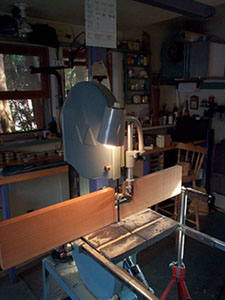Resawing Walnut
The process of converting wood from a tree involves many steps before it is ready for processing in the shop. Once the wood has been harvested and is dry enough, we begin with sawing a quartersawn billet of wood into pairs of thin slices. This is called "resawing". Then we glue these paired slices together in a process called "bookmatching."
Resawing your own wood gives you much greater aesthetic and acoustic control of your materials. Many luthiers buy "top sets" or "back sets" or "side sets" from woodcutters who specialize in serving the musical instrument community with instrument-grade wood. A Master Grade suit of woods for a musical instrument can cost hundreds of dollars, and form a significant portion of the final cost.
The problem is that, except in a few cases, the woodcutter is not a luthier, so the grading of wood can only be based on knowledge of the specific tree the wood is taken from, and the visual appearance of the wood. These are very valuable judgements to make, but when you buy a set of wood for a music instrument, you are constrained by the judgement of the woodcutter. You take the set he selects for you, unless you can go to his lumber room and search through his stock looking for the piece you judge to be best.
But a few woodcutters will agree to grade wood in the "rough" and sell billets of wood split directly from the tree. They may then run these split "flitches" through their bandsaw to get rid of gross waste, and the product is an odd-shaped lot of wood that is thought to be more or less the grade the luthier is after, but no guarantees. The price may be a little lower, but what you are actually after as a luthier is not so much a better price as the opportunity to process the wood into "sets" yourself. Now you have broken through the barrier of ordering your component wood and taking whatever the woodcutter selects for you. Now you are building your own stock, and doing your own selecting.
How you proceed with cutting wood from a log depends on whether you are beginning by splitting or sawing. If you are dealing with spruce, redwood, or some other nicely straight-grained wood, you might consider splitting. Cut the log into lengths of your top/back sets (allowing a few inches for checking). You will get a lot of wasteage from run-out but you will get very best tonewood that way. If you are cutting hardwood, sawing the billets out is about the only way, as most hardwoods' grain is toovariegated to split well. You will do best to cut boards out the whole length of the log. This will also optimize your cutting out of back/topsets later, as you will have the advantage of seeing imperfections hidden inside the log but revealed during your billet cutting. Even in the case of spruce and redwood, you can begin with a split-out large billet, plane that surface, then use it as a reference surface.
I begin sawing a log by taking a billet out of the center. There will always be one orientation that will get you the best billet. You want to choose the orientation so that the grain is more or less straight across the thickness of the board. The center cut will look like this: (((((O)))))). Next, take the two halves and get center cuts out of them. You want to cut out the thickest boards you can, to maximize the number of resawn back or top sets you can get out of these three boards. Then inspect the remaining pie-shaped billets to see if there is enough in them to get more topsets/backsets, or smaller stuff out of them.
Only if your are splitting rather than sawing would I go right for pie-shaped cuts. You will get a lot of wasteage from run-outs and other accidents, especially if you try to go for real thin billets. BTW, I recently read in Robert Lundberg's "Historical Lute Construction" that wood splits easiest in the direction of top to bottom as the wood stood in the tree.

